Nancy Marie Brown's Blog, page 5
March 16, 2016
Viking Women Were "Very Stirring"
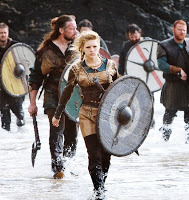 What were Viking women like? Were they really as tough and macho as Lathgertha in the History Channel's "Vikings" series?
What were Viking women like? Were they really as tough and macho as Lathgertha in the History Channel's "Vikings" series?The Icelandic sagas, although written hundreds of years after the Viking Age people and events they describe, can give us some hints--especially if we examine their descriptions word for word.
Gudrun the Fair, heroine of Laxdaela Saga, for example, is one of many saga women described as a skörungr. It's a word translators have serious trouble with--although the saga-writer clearly thinks it's a compliment. In modern Icelandic, the word means a fireplace poker. Concentrating on what a fireplace poker does, William Morris in the 1890s came up with "a very stirring woman." And Gudrun does stir things up, mostly trouble.
Yet a man labeled a skörungr Morris called "a shaper" or "a leader." Other early translators turned a female "poker" into "brave-hearted," "high-spirited," "noble," "of high mettle," "fine," "superior," "of great magnificence," and "a paragon of a woman." They might have done better to think what a poker looks like. For skörungr does, in the end, have to do with manhood. The root skör means an edge, like the edge of a sword.
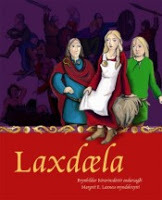 Let's look more closely at Gudrun the Fair. The female characters in Laxdaela Saga are so strong and admirable that some readers suspect the story was written by a woman in response to some of the other, more male-oriented, sagas. We read of Unn the Deep-Minded, who emigrated from Scotland with all her kin, claimed a chunk of land "as big as a man's," parceled it out to her followers, and lived out her life as a chieftain in all but name, marrying off her grandchildren to make alliances. There is Melkorka, who comes to Iceland as a sex-slave: Melkorka pretended to be a deaf-mute, revealing nothing. Not until she was caught speaking Irish to her son, Olaf the Peacock, did she admit she was the daughter of an Irish king. After her status as a princess came out, her owner bought her a farm and set her up as an independent woman. Olaf married well and had five sons and three daughters. He offered to raise his half-brother's son, Bolli, to mend fences in the family, and with that we come to the crux of the saga.
Let's look more closely at Gudrun the Fair. The female characters in Laxdaela Saga are so strong and admirable that some readers suspect the story was written by a woman in response to some of the other, more male-oriented, sagas. We read of Unn the Deep-Minded, who emigrated from Scotland with all her kin, claimed a chunk of land "as big as a man's," parceled it out to her followers, and lived out her life as a chieftain in all but name, marrying off her grandchildren to make alliances. There is Melkorka, who comes to Iceland as a sex-slave: Melkorka pretended to be a deaf-mute, revealing nothing. Not until she was caught speaking Irish to her son, Olaf the Peacock, did she admit she was the daughter of an Irish king. After her status as a princess came out, her owner bought her a farm and set her up as an independent woman. Olaf married well and had five sons and three daughters. He offered to raise his half-brother's son, Bolli, to mend fences in the family, and with that we come to the crux of the saga.Bolli was handsome and talented-second only to Olaf's own son, Kjartan. The two boys were best friends. Both fell in love with Gudrun the Fair, who had already been widowed twice when she met them. Gudrun loved Kjartan. Like every Icelandic boy his age, he decided to go to Norway to make a name for himself, and asked her to wait the usual three years for him. She suggested he take her abroad instead. He refused. She refused to promise to wait. Three years passed, and he didn't come home. But Bolli did, full of tales of the impression Kjartan had made on the king's beautiful sister.
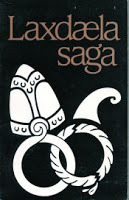 Bolli was not lying; his crime was more on the order of wishful thinking. Still, while Kjartan was "talking" with the king of Norway's sister, Bolli wooed and wed Gudrun. Then Kjartan returned home. His sister counseled him to "do the right thing" and make peace with his friend and cousin Bolli. She introduced Kjartan to a fine woman of good family, and Kjartan was soon happily married.
Bolli was not lying; his crime was more on the order of wishful thinking. Still, while Kjartan was "talking" with the king of Norway's sister, Bolli wooed and wed Gudrun. Then Kjartan returned home. His sister counseled him to "do the right thing" and make peace with his friend and cousin Bolli. She introduced Kjartan to a fine woman of good family, and Kjartan was soon happily married.Gudrun became insanely jealous. Sometimes she thought Bolli had tricked her into marrying him. Other times she believed Kjartan had spurned her and, when he had come home and made light of her marriage, had insulted her. And indeed, he did insult her after a golden headdress he had given his wife (a gift from the princess intended for Gudrun) was stolen. Kjartan gathered his men and surrounded Gudrun's house, forcing everyone to go to the bathroom inside for several days with no indoor privy. Gudrun arranged his death and then deeply regretted it. As she told her son many years later, "I was worst to the one I loved best."
But for none of these deeds is Gudrun called a skörungr. That comes on the occasion of her fourth marriage. At the urging of her staunch supporter, the chieftain Snorri of Helgafell, and with the agreement of her young sons, Gudrun betrothed herself to Thorkel Eyjolfsson, a wealthy trader and friend of the king of Norway. Gudrun had extensive landholdings and the backing of many men who had been loyal to her recently deceased father. Since her brothers were all exiled after killing Kjartan, Gudrun's husband would wield the influence of a chieftain.
 As a mark of her power in the relationship, Gudrun insisted on holding the wedding at her own farm, bearing the cost herself. Among the 160 wedding guests, however, her bridegroom Thorkel recognized a man who had killed one of his friends. Thorkel grabbed the criminal and was about to put him to death when Gudrun stood up from her place at the women's table, brushed her fancy linen headdress out of her eyes, and called to her men, "Rescue my friend Gunnar and let nothing stand in your way!"
As a mark of her power in the relationship, Gudrun insisted on holding the wedding at her own farm, bearing the cost herself. Among the 160 wedding guests, however, her bridegroom Thorkel recognized a man who had killed one of his friends. Thorkel grabbed the criminal and was about to put him to death when Gudrun stood up from her place at the women's table, brushed her fancy linen headdress out of her eyes, and called to her men, "Rescue my friend Gunnar and let nothing stand in your way!"As the saga so nicely understates it, "Gudrun had a much bigger force. Things turned out differently than expected."
Before anyone could draw a sword, Snorri of Helgafell stood up and laughed. "Now you can see what a skörungr Gudrun is, when she gets the better of both of us."
What quality is Chieftain Snorri admiring? Translators from 1960 to 2002 have called Gudrun and her saga sisters "exceptional," "outstanding," "remarkable," "determined," "forceful," "capable," "brave," "of strong character," "one to be reckoned with," and a woman "with a will very much her own." These are better than the nineteenth century's "high-mettled" and "very stirring," but they're still not quite right.
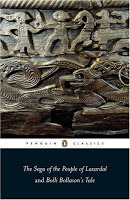 Historian Jenny Jochens turns skörungr into "manly," and the best equivalent is indeed man. Imagine if the situation were reversed. Gudrun spotted the killer of her friend on Thorkel's side of the hall. Thorkel had the bigger fighting force. Chieftain Snorri, eager to make peace and see the wedding proceed (and it does), stepped in, laughed, and said to Gudrun, "Now you can see what a man you're marrying, when he gets the better of both of us."
Historian Jenny Jochens turns skörungr into "manly," and the best equivalent is indeed man. Imagine if the situation were reversed. Gudrun spotted the killer of her friend on Thorkel's side of the hall. Thorkel had the bigger fighting force. Chieftain Snorri, eager to make peace and see the wedding proceed (and it does), stepped in, laughed, and said to Gudrun, "Now you can see what a man you're marrying, when he gets the better of both of us."A Viking's character was not either male or female, but lay on a spectrum ranging from strong to weak, aggressive to passive, powerful to powerless, winner to loser or, in the Old Norse terms, hvatr to blauðr. Hvatr, always a compliment, means "bold, active, vigorous." It appears to be related to the verb hvetja, a cognomen for our verb "to whet"--to sharpen (a sword), to put a good, sharp skör (or edge) on it. Its opposite, blauðr, always an insult, means "soft, weak." It is, says the standard dictionary, "no doubt a variant of blautr," which means "moist." Hard, sharp, and vigorous versus soft, yielding, and moist. Think dirty and you've got it.
When the beautiful skörungr Hallgerd Long-legs called Njal, the hero of Njal's Saga, "Old Beardless," she was not saying he was funny-looking: She was saying he was blauðr--weak, cowardly, powerless, and craven. A loser.
And when Chieftain Snorri praised Gudrun the Fair as a skörungr, and a better one than both himself and Thorkel Eyjolfsson, he was locating her far out on the male end of the power spectrum. He was calling her a winner.
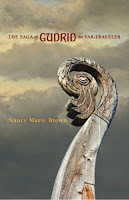 "This is a world," writes Old Norse scholar Carol Clover, "in which 'masculinity' always has a plus value, even (or perhaps especially) when it is enacted by a woman." There was only one standard, only one way to judge a person adequate or inadequate. "The frantic machismo" of the men in the Icelandic sagas, Clover concludes, suggests "a society in which being born male precisely did not confer automatic superiority, a society in which distinction had to be acquired, and constantly reacquired, by wresting it away from others."
"This is a world," writes Old Norse scholar Carol Clover, "in which 'masculinity' always has a plus value, even (or perhaps especially) when it is enacted by a woman." There was only one standard, only one way to judge a person adequate or inadequate. "The frantic machismo" of the men in the Icelandic sagas, Clover concludes, suggests "a society in which being born male precisely did not confer automatic superiority, a society in which distinction had to be acquired, and constantly reacquired, by wresting it away from others."The women who are mentioned in the sagas, the ones who are admired as skörungr, are the ones who have acquired that distinction. Among them is Gudrid the Far-Traveler, about whom I have written two books: the young adult novel, The Saga of Gudrid the Far-Traveler (2015), and the nonfiction book The Far Traveler: Voyages of a Viking Woman (2007), from which this discussion of skörungr was taken.
Read more about Viking women on my blog here:
http://nancymariebrown.blogspot.com/2013/03/valkyrie-or-shield-maiden.html
http://nancymariebrown.blogspot.com/2014/01/poet-maidens-and-shield-maidens.html
Published on March 16, 2016 09:44
March 9, 2016
Cook Like a Viking
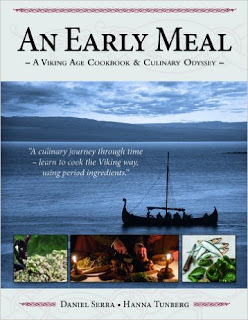 What did the Vikings eat? We imagine them gorging on roast leg of lamb and buckets of ale. In Valhalla, according to Snorri Sturluson, the heroes eat boiled pork and drink bottomless horns of mead. When Odin and Loki dine out, in one myth, they spit-roast an ox (though Odin is said elsewhere to subsist only on wine).
What did the Vikings eat? We imagine them gorging on roast leg of lamb and buckets of ale. In Valhalla, according to Snorri Sturluson, the heroes eat boiled pork and drink bottomless horns of mead. When Odin and Loki dine out, in one myth, they spit-roast an ox (though Odin is said elsewhere to subsist only on wine).But is all that meat and alcohol realistic?
Daniel Serra, one of the authors (with Hanna Tunberg) of An Early Meal: A Viking Cookbook & Culinary Odyssey, thinks not.
Serra is an archaeology student--the book is based on his Ph.D. dissertation--and a Viking re-enactor who was hired to "reconstruct Viking Age food" by the Lofotr Viking Museum in Lofoten, site of the largest Viking longhouse ever discovered, in the far north of Norway.
There's nothing like having to actually do it to make you figure out how something was done.
His book concentrates on Norway, Denmark, and Sweden. Beginning at Lofoten, he takes the reader (or cook) on a "culinary odyssey," sailing to important archaeological sites at Kaupang, Lejre, Hedeby, Uppåkra, and Birka, with a side trip to Jorvik in England. For each site, he describes the archaeological evidence for what people in Viking times ate and how they prepared it.
We can learn a lot from bones, seeds, utensils, pots, and, yes, feces.
Serra also explores the Icelandic sagas and other post-Viking Age written sources for hints on food and cooking, such as the stories of yogurt-like skyr being stored in leather bags, vats of whey big enough for a man to hide in, cheeses made in round cheese forms, porridge served with a large ladle, and leek or onion soup fed to a wounded man to determine (by the smell) if his intestines had been pierced.
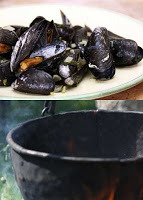 Serra and Tunberg then create a few recipes that plausibly could be connected with each archaeological site, being careful to only mix foods that were available and in season. This is the ultimate in seasonal, locavore cooking--with a very few luxury items thrown in, where the archaeological record warrants it.
Serra and Tunberg then create a few recipes that plausibly could be connected with each archaeological site, being careful to only mix foods that were available and in season. This is the ultimate in seasonal, locavore cooking--with a very few luxury items thrown in, where the archaeological record warrants it.Don't expect a lot of spice. The Vikings used mustard seeds (both black and yellow), thyme, dill, caraway, coriander, and lots of onions, leeks, and garlic. Salt was expensive to buy or, if home-made (by burning seaweed), labor-intensive and inefficient to make.
Sweets were scarce: The main sources were dried or frost-bitten berries and fruits, honey (expensive, as bees could only survive in some parts of Scandinavia), and malt (which was mostly used for making ale).
The most common taste was sour: Turnips and kale, as well as sausages and joints of meat, were pickled in whey, the leftover fluid from cheese-making. Whey was also the drink of choice, when ale wasn't available--and sometimes the two were mixed (ugh).
And that roast leg of lamb? It was more likely to be smoked or dried, then cut up and cooked as a stew with onions and turnips.
Valhalla's boiled pork doesn't sound nearly so tasteless, though, when you read Serra and Tunberg's recipe for Boar Stew: It contains leeks, butter, bacon, boar's meat, mustard, kale, wheat seeds, and thyme, along with the boiled pork. The photograph makes it look actually appetizing.
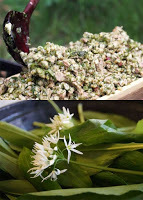 The recipes throughout An Early Meal are, in fact, beautifully illustrated. The instructions are clear and easy--according to my friend Linda, an excellent cook who reads cookbooks for pleasure--and the book's paper and binding are sturdy enough to survive heavy kitchen use.
The recipes throughout An Early Meal are, in fact, beautifully illustrated. The instructions are clear and easy--according to my friend Linda, an excellent cook who reads cookbooks for pleasure--and the book's paper and binding are sturdy enough to survive heavy kitchen use.Still, I only found a few meals I'd want to try. (Linda, more adventurous in her eating, found more.) For me, the value of the book is for re-enacting--in fiction--what Viking life was really like.
I learned, for instance, how to make a cooking pit to roast a goat. Did you know that you should put the layer of stones under the firewood if you plan to use the pit more than once, but lay them over the firewood if the ground is cold? And how do you keep the meat from charring? Serra suggests several medieval replacements for aluminum foil.
Did you know that to make dried cod tasty, you should beat it with a wooden mallet for "well over an hour," then soak it in hot water for at least 12 hours?
Or that Vikings ate lots of hazelnuts? Mixed with honey, says a medieval Scandinavian herbal, they are good for a cough.
Or that the best way to cook the mash and boil the wort, when making large quantities of ale, was to heat stones in the longfire, then drop them one by one into a large tub of mash or wort until it reached the required temperature? (Your thermometer in this case was your finger.) If making a smaller quantity of ale, you use smaller tubs and smaller stones--these stones are called "pot-boilers." How often have I used that term to refer to a formulaic mystery novel without knowing what it really meant?
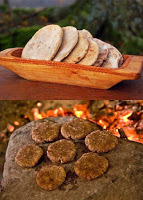 Then there's the question of bread. I knew grain was hard to grown in Iceland, but I assumed bread was common throughout the rest of Scandinavia. Archaeologists have found signs of bread in burials and funeral pyres. They could tell it was unleavened, cooked on a griddle or a hot stone (rarely baked in an oven), and made of some mixture, depending on the location, of barley, oats, wheat, rye, pea, and broad-bean flours.
Then there's the question of bread. I knew grain was hard to grown in Iceland, but I assumed bread was common throughout the rest of Scandinavia. Archaeologists have found signs of bread in burials and funeral pyres. They could tell it was unleavened, cooked on a griddle or a hot stone (rarely baked in an oven), and made of some mixture, depending on the location, of barley, oats, wheat, rye, pea, and broad-bean flours.I never gave a thought to how hard it was to grind the flour. That's why I love experimental archaeology. When Daniel Serra made bread at the Lofotr Viking Museum, he started with grain (seeds) and a hand quern.
He describes the quern as "two stone discs on top of each other." The stone is mica-schist with small hard garnets in it. The larger stone, on the bottom, "is fixed by nothing else but its weight." The upper stone has a handle; sometimes that handle extends to the roof of the building to get better torque. "In order to get the best result," Serra writes, "the cereals must be fed to the quern constantly so that friction is kept low and the two discs suffer less wear."
And you don't just feed the cereals in once. "Grinding with a hand quern is hard work." In his experiment, Serra ground half a kilogram (18 ounces) of grain; a bread recipe he includes in An Early Meal uses about that much barley flour for a loaf meant to feed four (modern) people as part of a larger meal.
"The experiment showed that the seeds had to be ground several times and sieved in order to achieve a flour that was fine enough with which to bake. After two grindings, the grains were fine enough to be used for a porridge. After another four or five more sessions, and half an hour, the seeds were fine enough to bake with. With experience and the right conditions, the time could probably be halved. The time and effort needed suggests that one would produce only enough flour to cover the needs of the day."
 Making flour for bread "was a rather strenuous activity," he concludes, adding that "Milling seems to have been mainly considered a female chore, and some skeletal remains have a tear in the shoulder joints which may stem from constantly working with a hand quern."
Making flour for bread "was a rather strenuous activity," he concludes, adding that "Milling seems to have been mainly considered a female chore, and some skeletal remains have a tear in the shoulder joints which may stem from constantly working with a hand quern."Don't assume, though, that Viking women did all the cooking. "In Norwegian burials," Serra points out, "certain cooking implements have been almost equally distributed between men and women--e.g., frying pans, spits, and soapstone vessels."
It's for these sorts of insight that An Early Meal deserves a spot on your bookshelf.
An Early Meal: A Viking Age Cookbook and Culinary Odyssey, by Daniel Serra and Hanna Tunberg, was published in Sweden in 2013 by ChronoCopia Publishing. I purchased my copy over Amazon.com.
For more about food in Norse mythology, see these earlier blog posts:
http://nancymariebrown.blogspot.com/2015/12/did-viking-greenland-collapse.html
http://nancymariebrown.blogspot.com/2013/01/seven-norse-myths-we-wouldnt-have_16.html
For more on Snorri Sturluson and the making of Norse mythology, see my book Song of the Vikings: https://www.nasw.org/users/nmb/books.html#SV
Published on March 09, 2016 06:58
March 2, 2016
The Sunstone, or how did Vikings navigate?
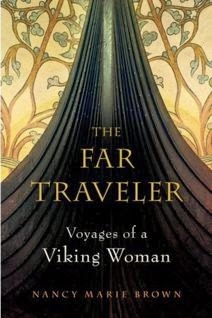 Elise Skalwold graciously calls it a typo. In her article "Double Trouble: Navigating Birefringence", she explains in scientific detail how the Vikings could use a crystal called a "sunstone" to navigate when out of sight of land. At the end of the article, she calls out my book:
Elise Skalwold graciously calls it a typo. In her article "Double Trouble: Navigating Birefringence", she explains in scientific detail how the Vikings could use a crystal called a "sunstone" to navigate when out of sight of land. At the end of the article, she calls out my book:"That ancient Viking mariners made such voyages sans modern instrumentation inspires awe in many, not least of all me, as I have traveled in those waters in more modern craft, as well as been out on a replica of a cabinless sea-faring longboat. For a glimpse into the Viking sea-faring world, the authors recommend The Far Traveler: Voyages of a Viking Woman by Nancy Marie Brown, but in regards to the sunstone, beware the typo which identifies it as 'Icelandic feldspar.'"
It should be "Iceland spar."
I'm not the only one to make this mistake, Elise told me when we met last October at Cornell University. The name "sunstone" is commonly used in English to refer to completely different minerals in the feldspar family, particularly a translucent type known as "aventurescent feldspar." This feldspar is sunny because it contains tiny, flat mineral inclusions that, when the stone is turned the right way toward the light, give off a bright flash.
This sunstone is not the Viking sunstone. The Viking sunstone is more bizarre even than that.
Elise came to listen to me lecture on my latest book, Ivory Vikings, but also to give me a quick lesson in mineral identification. For Elise is a consulting gemologist. In her backpack, she had samples of Iceland spar and a copy of the book Secrets of the Viking Navigators, by Leif K. Karlsen, which she generously gave to me.
My reaction to the crystal she set in my palm that afternoon was very much like Karlsen's. He writes, "In a natural world that is filled with rare and exquisite examples of incredible uniqueness, sunstones defy the rational mind."
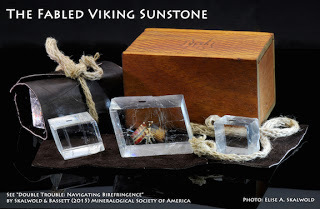
It is ice-clear. But worse, it looks machined. Living in a modern world I simply can't look at it properly. My eyes tell me it has been cut, that it's manmade, that it's fake.
And it's not. No wonder the Icelandic Saga of Hrafn Sveinbjarnarson considers the gift of a sunstone equal to that of a pair of fine stallions.
"Sunstones," Karlsen writes, "are roughly the shape of a three-dimensional parallelogram. All sunstones, without exception, have the same geometric shape and the same angularity. Take a large sunstone and break it into smaller pieces and you will have pieces with the exact same angles and geometry as the original. Additionally, every face of the stone has a tilt of 11.5 degrees."
Imagine finding something like that on an Icelandic mountainside. Just looking at it, you'd know it was magical.
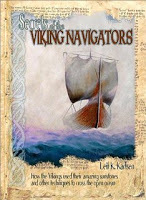 And the Vikings did find sunstones there. Karlsen names three places in Iceland where the crystals are readily found. He even visited one, the site of an old mine. "In the days before synthetics," he notes, "this mineral was also used for various types of scientific optical equipment such as microscope lenses." Karlsen met an old man named Gisli who had worked at the mine in 1937 and offered to take him there.
And the Vikings did find sunstones there. Karlsen names three places in Iceland where the crystals are readily found. He even visited one, the site of an old mine. "In the days before synthetics," he notes, "this mineral was also used for various types of scientific optical equipment such as microscope lenses." Karlsen met an old man named Gisli who had worked at the mine in 1937 and offered to take him there."After some rough driving on gravel roads with several unbridged rivers and streams and then cross-country where there were no roads, we arrived safely at our destination," Karlsen writes. "We climbed up to a plateau about 400 feet up the mountain. ... Gisli pointed out numerous pieces of Iceland spar that had washed out of the vein higher in the mountain and then tumbled down the mountain in the scree. Some of the stones were clear and shiny where they had broken along the facets of the crystal as they fell. Others had an opaque surface due to weathering and abrasion. Many of the pieces we saw were at least 1.5 x 2 x 1 inches ... large and clear enough to be used for navigation."
How did the sunstone work? If you want the technical answer, read "Double Trouble: Navigating Birefringence."
But if you just want the gist of it, Karlsen presents it as a short story in his book, Secrets of the Viking Navigators. During a fictional Viking voyage, the navigator teaches his younger brother "the secrets of the sunstone."
"To use the sunstone," he says, "you must place a small spot of pine tar on top of the stone, on the side which faces towards the sky. When you are using the crystal for the first time, place a small wooden pointer along either one of the longest sides. This will be a guide for which side to point toward the brightest part of the sky. Then you must hold the stone overhead and view the stone from underneath. Notice the double image of the black dot? ... When you rotate the stone slightly back and forth, holding it flat, you will see that one spot fades and the other becomes darker. When the two images appear to be equal in value, note the position of the stone and the direction of the pointer. This is the true bearing to the sun."
Karlsen tried it out on a replica Viking ship sailing the coast of Norway in 1996. Playing the part of the navigator, he was able to teach each of his crew members how to use the sunstone--and confirmed their results with modern instruments.
 Its optical magic is most impressive under conditions of "Arctic sea smoke," when very cold air moves over warmer water and the ship is wrapped in fog almost to the top of its mast. "When the light from the rising or setting sun was lost in the fog bank, but the zenith was clear," he writes, "the navigator could tell the exact position of the sun by using the sunstone, even though the sun itself was unseen."
Its optical magic is most impressive under conditions of "Arctic sea smoke," when very cold air moves over warmer water and the ship is wrapped in fog almost to the top of its mast. "When the light from the rising or setting sun was lost in the fog bank, but the zenith was clear," he writes, "the navigator could tell the exact position of the sun by using the sunstone, even though the sun itself was unseen."I'll remember that the next time I imagine a Viking voyage.
"Double Trouble: Navigating Birefringence," by Elise A. Skalwold and William Bassett, was published in late 2015 by the Mineralogical Society of American and is available online here: http://www.minsocam.org/msa/openaccess_publications/#Skalwold_01
Leif K. Karlsen's Secrets of the Viking Navigators was published in Seattle by One Earth Press in 2003.
For more on The Far Traveler, see my website at: https://www.nasw.org/users/nmb/books.html#FT
Published on March 02, 2016 07:14
February 24, 2016
Were the Lewis Chessmen Made in Trondheim?
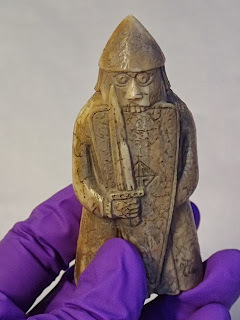 Google "Lewis chessmen" and--unless you come up with my book Ivory Vikings--you'll probably learn that they were made in Trondheim, Norway between 1150 and 1200. How do we know that? Actually, we don't.
Google "Lewis chessmen" and--unless you come up with my book Ivory Vikings--you'll probably learn that they were made in Trondheim, Norway between 1150 and 1200. How do we know that? Actually, we don't.Although the "Trondheim theory" of the origins of the Lewis chessmen is often presented as fact, art historians have been debating whether they were made in Iceland or Norway or Scotland or England or somewhere else ever since the chessmen were first studied at the British Museum in 1832. As one expert concluded in 1909, "Artistic influences were constantly interchanged, and common features of ornament are found on both shores of the North Sea, with the result that it is often difficult to say to which side a given object belongs."
When Icelandic art historian Bera Nordal studied the motifs on the Lewis chessmen in 1992, she compared them to stone carvings and wooden stave churches in Norway, to other walrus-ivory objects in the British Museum and the Danish National Museum, and to a little-known collection of Romanesque wood carvings in the National Museum of Iceland. She reached "no conclusive answers as to whether the Lewis chessmen originated in Norway or Iceland" or somewhere else.
Nordal's work on the Icelandic wood carvings is missing from most discussions of the Lewis chessmen. She wrote in Icelandic and published in an obscure journal.

Instead, experts cite a short report from two years earlier by a pair of archaeologists working in Trondheim, Chris McLees and Oeystein Ekroll, who published in English in the prestigious journal Medieval Archaeology. For many, McLees and Ekroll clinched the Trondheim theory. Their report discusses "a small sculpture of a Madonna with the Christ child, beautifully carved in ivory," that was found on the ancient site of Saint Olav's Church in Trondheim in the 1880s--and subsequently lost. All that remains are three sketches.
Rifling old files for information on Saint Olav's church, which was demolished in 1702, archaeologist Ian Reed stumbled upon the sketches and a few details from the finder's report. He shared this information with McLees and Ekroll. To them the sculpture was no Madonna but a Lewis chess queen. As sketched, the figure wears a veil but no crown. Only her head and one arm remained to be drawn, but the right hand was all that the researchers needed: She holds her hand to her cheek.
Touring modern-day Trondheim, especially with the authors of this report--as I did to research Ivory Vikings--it's not hard to find motifs like those on the Lewis thrones in Nidaros Cathedral, on stones displayed in the Bishop's Palace Museum, on the wall of a small church down a side street, and in the ruins of Saint Olav's Church (preserved inside the new library).
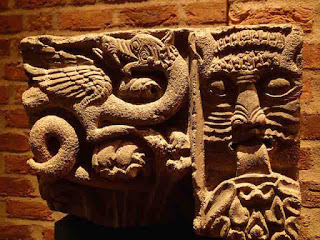
But the Trondheim theory is not watertight. To support their theory, McLees and Ekroll list in their paper "the characteristic 'Trondheim Group' of stave-church portals; the local strain of ornamental stone carving in the district's Romanesque stone churches...; and, if the inferences implicit in the motifs common to a number of carved ivories, including a possible crozier head found on the nearby island of Munkholmen, can be trusted, the range of skills and motifs shared by local sculptors also extended to the intricate carving of walrus ivory." The number of qualifiers in that last clause flags a problem the researchers readily acknowledge: Few of the artworks compared to the chessmen can be scientificially dated. Except for the stone carvings, none is indisputably a product of Trondheim.
An ivory chess piece, after all, would fit in an artist's pocket. The entire Lewis hoard could easily be transported by a carver coming from, say, Lund (then in Denmark, now in Sweden)--where another broken piece of a Lewis chessman, this time the front feet of a knight's horse, was found in the 1980s.
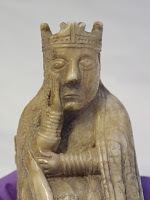 Or the chessmen could have been made in Iceland, as I argue, by an ivory carver named Margret the Adroit, who was hired to make luxury items for the bishop of Skalholt to send to his friends abroad.
Or the chessmen could have been made in Iceland, as I argue, by an ivory carver named Margret the Adroit, who was hired to make luxury items for the bishop of Skalholt to send to his friends abroad.I won't run through all the holes I poked in the Trondheim theory of the origin of the Lewis chessmen. You can read that for yourself (Chapter 4 of Ivory Vikings). It was, I think, the hardest part of the book to write--demolishing the theory of two clever and competent researchers whom I liked very much and who had been very generous with their time and expertise. I rewrote that section several times, trying to be fair. It's a good theory, I wanted to stress. It's just not the only one. And it's definitely not fact.
So I felt like I had aced an exam when I received, a few days ago, a letter from Chris McLees in Trondheim thanking me for sending him a copy of Ivory Vikings. "It was fun to see the story of the discovery of our Trondheim chess queen woven into the narrative as you did," he wrote. He hadn't finished the book, but "What I have read has greatly impressed me," he said.
"I reserve final judgment on your theory"--that the Lewis chessmen were made in Iceland, he added, "but I heartily agree that it is compelling. I'll get back to you on that after a closer reading."
I couldn't have asked for more.
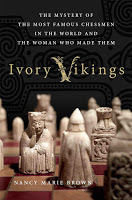 Read more about Ivory Vikings on my website, http://nancymariebrown.com, or check out these reviews:
Read more about Ivory Vikings on my website, http://nancymariebrown.com, or check out these reviews:"Briefly Noted," The New Yorker (November 2): http://www.newyorker.com/magazine/2015/11/02/briefly-noted-the-blue-guitar (scroll down)
"Bones of Contention," The Economist (August 29): http://www.economist.com/news/books-and-arts/21662487-bones-contention
"Review: Ivory Vikings," Minneapolis Star Tribune (August 29): http://www.startribune.com/review-ivory-vikings-by-nancy-marie-brown-the-mystery-of-the-lewis-chessmen/323230441/
Published on February 24, 2016 08:47
February 17, 2016
Vikings and the Edge of the World
 If you liked my book Ivory Vikings, and want to learn more about the North Sea culture in the Middle Ages, then the next book on your reading list should be The Edge of the World by Michael Pye.
If you liked my book Ivory Vikings, and want to learn more about the North Sea culture in the Middle Ages, then the next book on your reading list should be The Edge of the World by Michael Pye.There's some overlap. Pye covers some of the same ground--or waters--as I did. We're both fascinated by the Sea Road that connected the cultures bordering the North Atlantic and permitted ideas and art, as well as people, to travel freely around the north. But while Ivory Vikings emphasizes Iceland, The Edge of the World is centered on Amsterdam and the lands that will become the Netherlands. Reading the two books back to back shows how two writers can tackle the same topic--and produce completely different, if complementary, stories.
Pye has a wider historical sweep, too. While I focus on the years 793 to 1266, he is fascinated by the 14th, 15th, and even 16th centuries. Sometimes his grander sense of time can be confusing. In a paragraph on the history of written laws, for example, he jumps from the birth of Christ to the 12th century.
And, from my perspective, Pye gets some things wrong. His understanding of Iceland and Greenland, particularly their settlement, is a bit outdated and contradicted by newer research, as is his discussion of the Viking voyages to the New World. I found myself putting a lot of question marks, and a few exclamation marks, in the margins of these sections.
But though I might quibble with a few of Pye's conclusions, I learned quite a lot from the book.
His chapter on Fashion is particularly fun. "The great sagas from Iceland have everything you expect," he writes: "heroes, killings, dragons, feuds, great voyages, and great horrors. They also have something less likely: they have dandies."
Here he introduces one of my favorites, the future Earl of Orkney, Kali Kolsson. In Ivory Vikings, I discuss the references to chess in Kali's poetry; Pye zeroes in on his clothes. Fashion, he says, "is about choosing to reinvent yourself and your status."
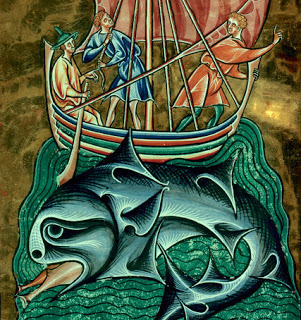
How exactly were the Vikings reinventing themselves? To explain, Pye tells me about some archaeological finds I was unaware of. The port town of Bergen, on the west coast of Norway, he points out, burned down repeatedly in the Middle Ages, leaving treasures for today's archaeologists.
"In the layers from the 11th to the 13th centuries, there are shoes--shoes for women, men, and children--and a startling number of them are decorated with embroidery in silk. Now, Lucca [near Rome] was beginning to produce silk in the 12th century, and grumpy Paris clerics had begun to denounce the wearing of 'worm's excrement,' but silk still seemed a luxury to Southerners, mostly imported from the Middle East. In later illuminated manuscripts, embroidered shoes are worn by grand and powerful people to show rank and to show money. But the Bergen evidence does not come from the parts of town with castles or riches; it is everywhere. There are so many shoes, even grown-ups' shoes cut down for children, that it's clear that silk yarn was being brought in quantity to the Norwegian coast long before it was the mark of social-climbing persons in Paris..."
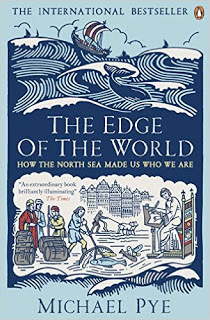 Finally, I have often wondered why Norway did not live up to its side of the bargain in the century after Iceland became subject to the Norwegian king. According to the agreement made at the Althing between 1262 and 1264, Norway was to send frequent ships carrying grain, timber, iron, and other staples Iceland needed: "Six ships are to sail from Norway to Iceland during each of the next two summers; from that time forth their number shall be decided according to what the king and the most judicious farmers in Iceland believe to be in the best interests of the country."
Finally, I have often wondered why Norway did not live up to its side of the bargain in the century after Iceland became subject to the Norwegian king. According to the agreement made at the Althing between 1262 and 1264, Norway was to send frequent ships carrying grain, timber, iron, and other staples Iceland needed: "Six ships are to sail from Norway to Iceland during each of the next two summers; from that time forth their number shall be decided according to what the king and the most judicious farmers in Iceland believe to be in the best interests of the country."Yet in historical hindsight, this agreement seems to end Iceland's years of prosperity along with its independence. The Golden Age was over. Iceland descended into its own Dark Ages of colonial repression. Until about 1600 the island was known to the rest of the world only for its rich offshore fishing grounds, its barbaric, uncultured people (said to wash in urine and dine on candle wax), and its volcanoes, one of which—Mount Hekla—was known as the Mouth of Hell.
As Pye explains, it wasn't Norway's fault. The Norwegians, too, were short of food at the end of the 1200s.
"The Norwegian ports, Bergen in particular, were waiting for the last shipments of the things they needed for the winter: grain for bread and beer, peas, beans, malt and flour. They had come to depend on these shipments; their year was measured out by the ships from Lübeck that took away their butter and dried cod, their furs and their good axes, and brought back basics from around the Baltic—where there was land to grow things, not like their own narrow fields between mountains and fjords and forests. They had once done business with the English as well, but now they depended on the Lübeck merchants of the Hansa."
The merchants of the Hansa League, a loose confederation of trading towns in what is now Germany, "seemed to do business just as they liked." Having gained a monopoly, they refused to sell "the winter essentials"--grain, flour, vegetables, and beer--to Norway until the Norwegian king gave them better terms. They blockaded the Norwegian ports until they got what they want. "Everything the Norwegians did after that seemed only to make them more dependent on the Hansa," Pye writes. They didn't send ships full of grain to Iceland because they couldn't.
"Something is beginning on the edge of the world: the kind of multinational power that does not depend on where it is based, which flirts or fights in the modern world with the obvious kinds of political and state power, which usually gets its own way," Pye concludes. Something that brought the old Viking world to its knees. "The modern trade-off between politics and money had begun."
The Edge of the World: A Cultural History of the North Sea and the Transformation of Europe by Michael Pye was published by Pegasus Books in 2015.
 Read more about Ivory Vikings on my website, http://nancymariebrown.com, or check out these reviews:
Read more about Ivory Vikings on my website, http://nancymariebrown.com, or check out these reviews:"Briefly Noted," The New Yorker (November 2): http://www.newyorker.com/magazine/2015/11/02/briefly-noted-the-blue-guitar (scroll down)
"Bones of Contention," The Economist (August 29): http://www.economist.com/news/books-and-arts/21662487-bones-contention
"Review: Ivory Vikings," Minneapolis Star Tribune (August 29): http://www.startribune.com/review-ivory-vikings-by-nancy-marie-brown-the-mystery-of-the-lewis-chessmen/323230441/
Published on February 17, 2016 13:48
February 10, 2016
Were Medieval Women Artists? How Do We Know?
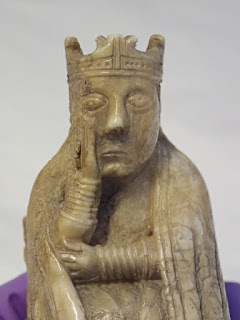 In the subtitle for my book Ivory Vikings, I took a chance. I dropped all the qualifiers. Rather than cluttering up the cover of my book with "may have" or "perhaps" or "maybe," I came out and said that a woman carved the Lewis chessmen.
In the subtitle for my book Ivory Vikings, I took a chance. I dropped all the qualifiers. Rather than cluttering up the cover of my book with "may have" or "perhaps" or "maybe," I came out and said that a woman carved the Lewis chessmen.The subtitle reads: "The Mystery of the Most Famous Chessmen in the World and the Woman Who Made Them."
Some reviewers objected: "Though more full of conjecture than the assertive subtitle suggests, Brown's account is nonetheless fascinating," said Publisher's Weekly.
"OK," said a reviewer for a medieval studies blog, "that title is quite attention grabbing: women as medieval sculptors and artisans? Not sure how that will be discernible in the art but I have not read the book yet so..."
In the text of the book, I do carefully re-insert all the "may haves" and "maybes." "Did Margret the Adroit carve the Lewis chessmen under a commission from Bishop Pall?" I ask in the introduction. "Unless the Skalholt dig is reopened, and proof of an ivory workshop is found, we cannot say yes or no. But 'the limited evidence' places Iceland on equal footing with Trondheim as the site of their creation."
I also rail against the book editors and graphic designers who take out all the qualifiers when asserting that the Lewis chessmen were made, instead, in Trondheim, Norway. Yes, I did it too; guilty as charged. Reader, beware: titles exaggerate. Marketing is not scholarship.
We cannot say if Margret the Adroit really carved the Lewis chessmen or not. Medieval artists did not sign their work. Gender is not, as that reviewer noted, "discernible in the art."
And yet, should we so matter-of-factly dismiss, as that reviewer seems to do, the idea that Margret was capable of it? "Women as medieval sculptors and artisans?" Really? Pshaw!
The Saga of Bishop Pall presents ample evidence that Margret the Adroit was a true "medieval sculptor," working on an equal footing with her male colleagues Amundi the Smith, Atli the Scribe, and Thorstein the Shrine-Smith at the cathedral of Skalholt in Iceland in the late 1100s and early 1200s. This contemporary saga, written within a generation of the bishop's death, has never been translated from Old Norse, however, so you can't expect every medieval scholar to be familiar with it.
So let's look for women artists in a more mainstream place: medieval Spain.
In 2008, a pair of researchers from Duoda, the Women's Research Center of the University of Barcelona, M.-Elisa Varela Rodríguez and Teresa Vinyoles Vidal, published the essay “Scattering Light and Colours: The Traces of Some Medieval Women Artists” in a series called The Difference of Being Woman: Research and Teaching of History. The essay, which includes the images reproduced below, can be downloaded here: http://www.ub.edu/duoda/diferencia/html/en/secundario13.html
In March 2014 it was circulated by the website Medievalists.net, which is where I learned of it. That link is: http://www.medievalists.net/2014/03/08/scattering-light-colours-traces-medieval-women-artists/
Rodriguez and Vidal write of women artists who lived and worked near Barcelona between the 10th and the 14th centuries--and who actually signed their work. "Some artists of embroidery wanted to leave their name for history," the researchers note.
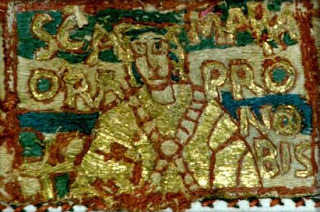 One was the late 10th-century abbess Maria de Santa Maria de les Puelles de Girona. The epitaph carved on her tombstone begins: "Maria of venerable memory, working with great effort every day on holy works..." Add Rodriguez and Vidal, "Maria wanted to leave a trace and she did so in the way that she knew how. In the parish church of Sant Feliu of Gerona a magnificently woven and embroidered stole is conserved ... on which there appear some letters that identify Maria as the author of the work." Those letters read: "[Remember], friend, Maria made me, whosoever wears this stole on themselves take it from me that they will have God as their help." The researchers continue, "Although the words 'know' or 'remember,' are blurred on the weaving, we can permit ourselves to interpret it in the following way: Maria wanted to be remembered, she was conscious that she had realised a laborious and beautiful work."
One was the late 10th-century abbess Maria de Santa Maria de les Puelles de Girona. The epitaph carved on her tombstone begins: "Maria of venerable memory, working with great effort every day on holy works..." Add Rodriguez and Vidal, "Maria wanted to leave a trace and she did so in the way that she knew how. In the parish church of Sant Feliu of Gerona a magnificently woven and embroidered stole is conserved ... on which there appear some letters that identify Maria as the author of the work." Those letters read: "[Remember], friend, Maria made me, whosoever wears this stole on themselves take it from me that they will have God as their help." The researchers continue, "Although the words 'know' or 'remember,' are blurred on the weaving, we can permit ourselves to interpret it in the following way: Maria wanted to be remembered, she was conscious that she had realised a laborious and beautiful work."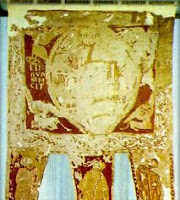 Another textile artist who wished to be remembered for her work was Elisava. She "signed the so-called banner of Sant Otto, which, originating in la Seu d’Urgell, is conserved in the Textile Museum of Barcelona. An art historian defines Elisava as commissioner of the piece," Rodriguez and Vidal write, "but we do not agree with that theory, we think that the clear affirmation 'Elisava me fecit' has to do with the real work, not only with paying for or sponsoring the work." They date the banner to 1122.
Another textile artist who wished to be remembered for her work was Elisava. She "signed the so-called banner of Sant Otto, which, originating in la Seu d’Urgell, is conserved in the Textile Museum of Barcelona. An art historian defines Elisava as commissioner of the piece," Rodriguez and Vidal write, "but we do not agree with that theory, we think that the clear affirmation 'Elisava me fecit' has to do with the real work, not only with paying for or sponsoring the work." They date the banner to 1122.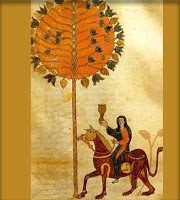 A third medieval Spanish woman artist painted the 115 miniatures in the Beato de Girona, "one of the richest manuscripts pictorially within the tradition of commentary on the Apocalypse." It is dated to 975. An inscription in the manuscript, as Rodriguez and Vidal interpret it, "clearly declares the authorship of the work to be of a woman with the name of En who is a painter, is fully aware of her task, and is also aware of its importance. … we interpret the text Dei aiutrix, helper of God, in that sense that through her the divine is transmitted to us … And she does it as a woman, which is why the illustrations of the Beato de Girona are different to that of other Beatos attributed to men painters. The Beato de Girona is the richest of miniatures, it is the richest in the palette of colours that it uses, and it is also unique in the interpretation that the painter makes of some scenes or passages."
A third medieval Spanish woman artist painted the 115 miniatures in the Beato de Girona, "one of the richest manuscripts pictorially within the tradition of commentary on the Apocalypse." It is dated to 975. An inscription in the manuscript, as Rodriguez and Vidal interpret it, "clearly declares the authorship of the work to be of a woman with the name of En who is a painter, is fully aware of her task, and is also aware of its importance. … we interpret the text Dei aiutrix, helper of God, in that sense that through her the divine is transmitted to us … And she does it as a woman, which is why the illustrations of the Beato de Girona are different to that of other Beatos attributed to men painters. The Beato de Girona is the richest of miniatures, it is the richest in the palette of colours that it uses, and it is also unique in the interpretation that the painter makes of some scenes or passages."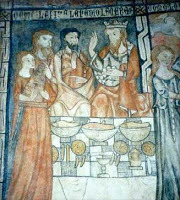 Is gender discernible in the art? These researchers believe it is, in this case and in that of the wall murals Teresa Diez painted in about 1316 for the Real Convento de Santa Clara de Toro, and which she also signed. Teresa chose to paint the life of Saint Catherine of Alexandria, contrasting feminine mediation and patriarchal power. "The exhibition of this pictorial-textual message, an explosion of colour and light, would undoubtedly move one to a religious devotion," Rodriguez and Vidal write. "Teresa Diez uses a language that is an invitaiton to life, full of poetry, light; an artistic language following the paths of the emerging gothic style. She interprets it in a personal way." Her work, they say, offers "an immense carpet of colour."
Is gender discernible in the art? These researchers believe it is, in this case and in that of the wall murals Teresa Diez painted in about 1316 for the Real Convento de Santa Clara de Toro, and which she also signed. Teresa chose to paint the life of Saint Catherine of Alexandria, contrasting feminine mediation and patriarchal power. "The exhibition of this pictorial-textual message, an explosion of colour and light, would undoubtedly move one to a religious devotion," Rodriguez and Vidal write. "Teresa Diez uses a language that is an invitaiton to life, full of poetry, light; an artistic language following the paths of the emerging gothic style. She interprets it in a personal way." Her work, they say, offers "an immense carpet of colour.""It should also be pointed out that," conclude Rodriguez and Vidal, "when so few names of women artists appear to us, it must be deduced that there were many more that were anonymous, and also others that history may still discover."
One of those women artists whom I hope other medievalists will soon discover, through my book Ivory Vikings, is the 12th-century ivory carver from Iceland, Margret the Adroit.
 Read more about Ivory Vikings on my website, http://nancymariebrown.com, or check out these reviews:
Read more about Ivory Vikings on my website, http://nancymariebrown.com, or check out these reviews:"Briefly Noted," The New Yorker (November 2): http://www.newyorker.com/magazine/2015/11/02/briefly-noted-the-blue-guitar (scroll down)
"Bones of Contention," The Economist (August 29): http://www.economist.com/news/books-and-arts/21662487-bones-contention
"Review: Ivory Vikings," Minneapolis Star Tribune (August 29): http://www.startribune.com/review-ivory-vikings-by-nancy-marie-brown-the-mystery-of-the-lewis-chessmen/323230441/
Published on February 10, 2016 06:53
February 3, 2016
America2Iceland's Sagas & Vikings Tour
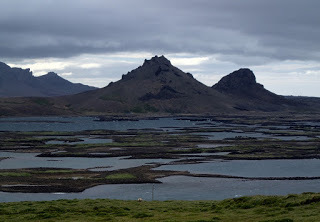 Iceland is the hot place to go these days (pun intended). Every week, it seems, I hear from someone who just "did" the land of fire and ice.
Iceland is the hot place to go these days (pun intended). Every week, it seems, I hear from someone who just "did" the land of fire and ice.Well, I've got news for you. You can't "do" Iceland in one trip. I've been going to Iceland since 1986--and the place isn't done with me yet.
It's not only that I've missed whole quadrants of the country. The places I know still astonish me. Each year, I notice something new or--paradoxically--very old, like the Viking Age longhouse that was discovered under a Reykjavik parking lot last year and is forcing a critical rethinking of the city's development.
And then there's the weather.
Last summer, from the farm where I like to stay, I gazed for days and days at the high white ice caps in the center of the island. But the one day we traveled toward the sea, the mountains by the coast wrapped themselves in clouds. Majestic Snaefellsjokull simply disappeared.
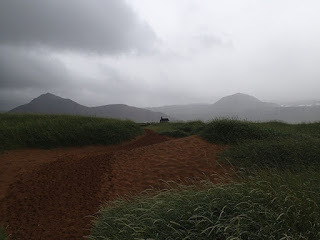
I knew it was there, laughing behind my back. The West is one part of Iceland I know very well: from Borgarnes to the Breiðafjorður, out to the tip of Snæfellsnes, and in to Surtshellir cave at the edge of the highlands. The West has a wonderful variety of landscapes--farms, fishing villages, lava fields, glaciers, beaches, waterfalls. On various trips I've found a path through the lava that had long been lost, crouched behind a rock while a sea eagle strafed me, rode a horse through a swift salmon river (careful not to let the eddies dizzy me), collected crowberries, watched fox pups play, rescued trapped sheep, frightened myself in a pitch-dark cave, drank sweet water from the well in another, soaked in a wilderness hot pool, sunned on the flank of a volcano.
I'm not a naturalist: What draws me to this part of Iceland are the medieval sagas, with their tales of sheep-farmers and sorcerors, horse fights and feuds, love and grief and hard times and strife. Tales of a satisfying life scratched from an unforgiving land. Tales tempered with poetry and grace.

These sagas, this landscape, has inspired nearly all my books. It's here that I found one perfect horse in A Good Horse Has No Color: Searching Iceland for the Perfect Horse (Stackpole 2001), and learned how Icelandic folklore and mythology are infused with horses.
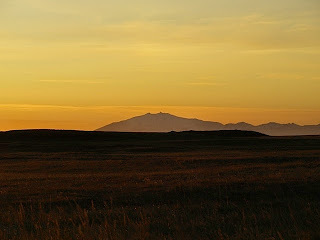
Here is where the story of Gudrid the Far-Traveler begins, the Viking woman who explored North America 500 years before Columbus. I've written about Gudrid twice, as nonfiction in The Far Traveler: Voyages of a Viking Woman (Harcourt, 2007), and in the young adult novel The Saga of Gudrid the Far-Traveler (Namelos 2015). Guðriður grew up on the tip of Snæfellsnes, in the shadow of the glacier some people call the third most holy spot on earth. (Seeing it rise out of the sea is certainly one of my favorite views of Iceland).
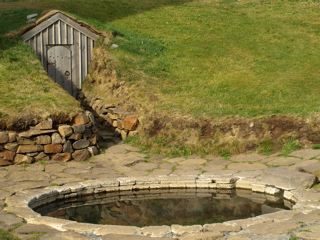
In the twelfth century, West Iceland was ruled by Snorri Sturluson, that unscrupulous chieftain who has become the most influential writer of the Middle Ages, in any language. My book Song of the Vikings: Snorri and the Making of Norse Myths (Palgrave Macmillan, 2012) is his biography. Here he wrote the Edda, which contains almost everything we know about Norse mythology. Here he wrote Heimskringla, his history of the kings of Norway. Here he probably wrote the first (and maybe the best) of the Icelandic sagas: Egil's Saga. And here he died, murdered, cringing in his cellar, for having betrayed the king of Norway.

Here, as well, Snorri and his family may have cornered the market on walrus ivory. As I argue in my latest book, Ivory Vikings: The Mystery of the Most Famous Chessmen in the World and the Woman Who Made Them (St Martin's 2015), the land of the sagas may also have been a land of world-class visual art in the Middle Ages.
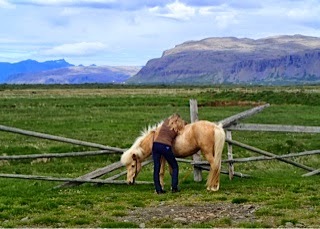
The best way to research my books, I've found, is to walk through the landscape where history happened, to live where my subjects lived and face some of the same challenges. To cross rivers on horseback, for example, or climb a volcanic crater. To experience the midnight sun in summer, when the birdsong never stills, as well as the dark days of winter (though I must admit, I've let a very few of them stand in for the rest). To marvel at the beauty of white glacier ice, black lava rock, blue (or slate-gray) sky, and jewel-green fields. To feel the spirits of the land in the breath of the wind, the sting of rain, and the warmth of the sun.
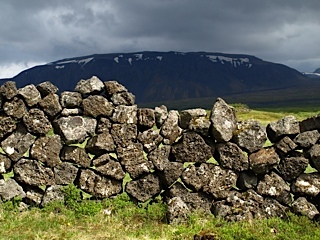
I'd like to bring you with me. Since 2012 I've been leading tours in West Iceland for the company America2Iceland, which is based on the farm of Staðarhús in Borgarfjörður. Earlier on this blog I've written about our Trekking Bootcamp I, an adventure tour for horseback riders.
But we also offer a tour for non-riders, for people who like to learn about Iceland's sagas and its Viking past. For people who'd like to meet real Icelanders and see more of the country than just the surface it presents to the usual tourist.
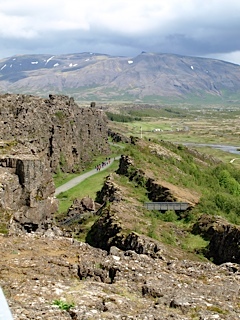 This year's "Sagas & Vikings" tour will take place from July 10-16. We'll begin in Reykjavik, with a visit to the Settlement Exhibition, then travel to Thingvellir, site of Iceland's ancient parliament and locus of many saga episodes. We'll end our day at Staðarhús, where we'll settle in for a week in a comfortable, family-run country hotel.
This year's "Sagas & Vikings" tour will take place from July 10-16. We'll begin in Reykjavik, with a visit to the Settlement Exhibition, then travel to Thingvellir, site of Iceland's ancient parliament and locus of many saga episodes. We'll end our day at Staðarhús, where we'll settle in for a week in a comfortable, family-run country hotel.Mornings we'll spend reading, taking nature walks, and observing the lifestyle of a traditional Icelandic horse farm. Those so inclined can take a riding lesson or short trail ride (for an additional charge).
Each morning's assigned readings, from my own books, will introduce the sights we'll see on our bus tour in the afternoon. We'll hike into the lava fields at Eldborg and Budir. We'll tour the sea caves and bird cliffs at Hellnar and Arnarstapi, and visit Gudrid's birthplace at Laugabrekka. We'll explore the town of Borgarnes, with its museums and geothermal pools, and Snorri's estate of Reykholt. We'll visit hot springs, wander along black and golden beaches, and see glaciers, volcanic craters, and waterfalls. And we'll meet the Icelandic horse and learn why the horse, not the dog, is "man's best friend" in Iceland.
Over dinner--a gourmet meal served at the farm--we'll discuss what we've learned and seen: How Iceland was settled, why the sagas were written, how the country has changed since the Middle Ages, how its culture has so powerfully influenced our own.
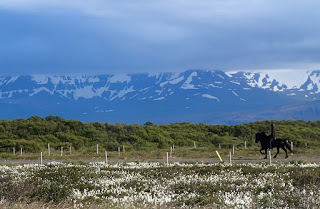
This tour is limited to 12 people, so each will get my personal attention. For more information, or to sign up, see America2Iceland.com or contact Rebecca at America2Iceland by email at info@america2iceland.com or phone at 1-828-348-4257. I think this is the perfect tour for first-time visitors to Iceland. Even if you've been to Iceland before, you'll see it in a completely new light.
Published on February 03, 2016 07:00
January 27, 2016
Riding the Long Beaches of Iceland
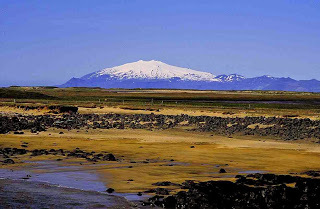 Along the west coast of Iceland, beneath the great glacier Snaefellsjokull, is a magical riding trail uncovered only at low tide.
Along the west coast of Iceland, beneath the great glacier Snaefellsjokull, is a magical riding trail uncovered only at low tide.This route, across the Longufjorur or "Long Beaches," has been in use by horsemen and women since the Saga Age. Before roads were bulldozed through the Eldborg lava fields in the early 1900s, it was the main highway. Until 1933 you'd buy your soap and nails and flour at a general store out there on the sands, where now you'll find only seals and seabirds, hear only the sounds of surf--or hoofbeats on sand.
"It's a dangerous path if you don't know the tides," my friend Haukur warned, when he took me on the trail for the first time in 1995. When I wrote about that experience in my book A Good Horse Has No Color, I summed it up this way: "This is Iceland."
This August I hope to recreate that ride--with your help. I'm looking for 8 adventurers to sign up for the Trekking Bootcamp offered by America2Iceland from August 10-16: see http://www.america2iceland.com/trips/riding-bootcamp-level-1/
 Photo by America2Iceland.comNote that you need to be a good rider (intermediate or advanced), though the breed of horse you usually ride doesn't matter much. We will, of course, be riding Icelandic horses (it's the only breed in Iceland), but if you can trot and canter all day long, you'll quickly learn to tolt. You also need to be able to swim, just in case.
Photo by America2Iceland.comNote that you need to be a good rider (intermediate or advanced), though the breed of horse you usually ride doesn't matter much. We will, of course, be riding Icelandic horses (it's the only breed in Iceland), but if you can trot and canter all day long, you'll quickly learn to tolt. You also need to be able to swim, just in case.Why? The trail cuts the mouths of several rivers, some of them deep-channeled salmon streams, others edged with quicksand. The safe paths shift from storm to storm, while the force of the wind and its direction, and the fullness of the moon, decide how fast a rider must cross.
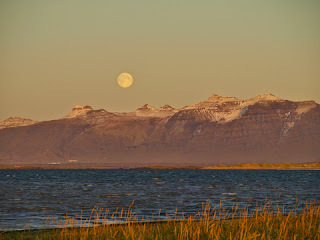
Ebenezer Henderson, a Scottish churchman who traveled throughout Iceland in 1814, described the crossing well: "We advanced at a noble rate, it being necessary to keep our horses every now and then at the gallop, in order to escape being overtaken by the tide before we reached the land. At one time we were nearly two miles from the shore; and I must confess I felt rather uneasy, while my companion was relating the number of travelers who had lost their lives in consequence of having been unexpectedly surrounded by the sea."
Henderson (or his guide) was exaggerating--but not much. In his book Summer at Little Lava my husband, Charles Fergus, told this story:

"A man known as Tobbi--short for Tobias--farmed during the 1600s along the Longufjorur.... Tobbi was known as a poet. One day a group of travelers asked him where they could safely cross over the sands. At work in his smithy, making a tool or repairing some article of iron, Tobbi answered them with a verse:
My work is going very slowly in the smithy,
Even through I'm clattering.
You should aim for Eldborg,
Under the hammer of Thor.
The travelers set off toward Eldborg. Perhaps they dawdled, crossing the sands. The tide rose and caught them, and they drowned. After that, Tobbi lost his ability to compose poetry and could bring forth only gibberish. He became known as Æra-Tobbi, 'Crazy Tobbi.' "

In 1995, riding with Haukur, an expert guide who knew the tides, I was in no danger. But I did get rather wet. We crossed over mudflats pocked with airholes and headed for several grass-topped islands abandoned by the tide like a pod of stranded whales. A sea eagle lifted off one of the islands as we approached and scolded us with a high-pitched cackle. Geese flew over, banking, startled.
We rode north onto the sandbar, across some grassy flats, back out through the sucky mud to the hard wet sand, whose color ranged from black to coffee-colored to tawny to gold. Tide pools, I knew, held tiny shrimp and sea lettuce; their bottoms were mosaics of shells.
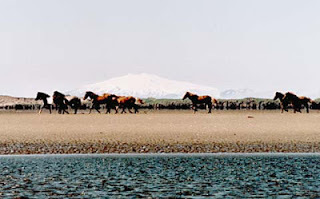
The horses got spattered with muck and splashed water as high as our faces—icy, but delightful in the sunshine, since everyone wore rubber boots and rainpants or chaps. These were practiced riders, and they kept up a fast pace. The woman next to me occasionally rode at a trot, balancing above her saddle to spell her mount, yet I matched her speed easily, tolting all the time. Later I overheard her remark to Haukur that I rode a tolt well for an American. He, knowing I understood her Icelandic, grinned at me. “It’s the horse,” he said.
With the islands to our left, we rode on hard-packed sand, the tapping of our horses’ hooves making music with the wind and the seabirds’ cries. I could feel time almost stop, suspended in the wet air between sea and sky, as history clustered all around us.
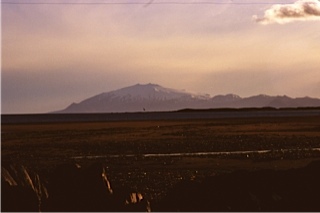
Close on our right rose the snow-flecked mountains of Snaefellsnes, the Snow Mountain Peninsula. Ahead loomed the Snow Mountain itself, glacier-topped Snaefellsjokull, a classic Mount Fuji-shaped stratovolcano. Jules Verne began his Journey to the Center of the Earth from this mountain, and New Agers now affirm it the third holiest spot on the planet, ascending it in droves on the summer solstice and bringing new riches to the fishing towns down below. Gazing at its beauty, I wondered what the two more-holy places could possibly be.

Then suddenly we were off the sands and into another farmyard. After a short rest, we decided to take a swim--but I've written about that on this blog before. Read it at: http://www.nancymariebrown.blogspot.com/2014/11/america2icelands-2015-trekking-bootcamp.html
This August, we'll be riding from Gudmar Petursson's farm of Stadarhus, about 40 km from the beach. We'll spend the first two days at the farm, getting used to our horses in a clinic that will get you ready for the trek.
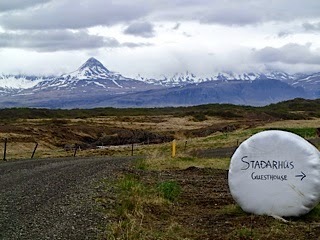
On Day 3 we'll ride 40 km to Hitarholmi, returning to Stadarhus for dinner, a soak in the hot tub, and a good night's sleep in private or double rooms (as we will each night). Day 4 is a 45 km stretch along the beach to Kolvidarnes--and we go whenever the tide is right, so it could be very early or very late. On Day 5, we'll do a 30 km ride out onto the sands and back to Kolvidarnes--again, whenever the tide is right. Then on Day 6, we'll turn inland, riding 30 km to Stori-Kalfalaekur, where we'll say goodbye to our horses. On Day 7, we'll regretfully fly home, with wind-chapped and sun-burned faces--or maybe a suitcase full of rain-soaked riding clothes, you never know. Either way, it will be a magical adventure.

Go to http://www.america2iceland.com/trips/riding-bootcamp-level-1/ and sign up now for the Trekking Bootcamp 1 on August 10-16. I can't wait to show you the Long Beaches of Iceland.
And if you're not a rider, note that I'm leading a tour this year for you, too. See the riding-optional "Sagas and Vikings" tour offered by America2Iceland on July 10-16: http://www.america2iceland.com/trips/song-of-the-vikings/. "Sagas and Vikings" is an educational trip for the whole family through the scenes and sagas that have inspired my many books about Iceland, including The Far Traveler, The Saga of Gudrid the Far-Traveler, Song of the Vikings, and the latest, Ivory Vikings.
Published on January 27, 2016 07:13
January 20, 2016
Iceland's Imaginary Landscapes
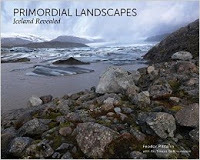 I'm reading Mountains of the Mind by Robert MacFarlane, a fine book that explores how the landscapes we see are mostly the result of our own imaginings. And I've just come home from a trip to Washington, D.C., where I was welcomed to the board of the Leifur Eiriksson Foundation, which awards $25,000 scholarships to Icelandic graduate students to study in America, or American graduate students to study in Iceland.
I'm reading Mountains of the Mind by Robert MacFarlane, a fine book that explores how the landscapes we see are mostly the result of our own imaginings. And I've just come home from a trip to Washington, D.C., where I was welcomed to the board of the Leifur Eiriksson Foundation, which awards $25,000 scholarships to Icelandic graduate students to study in America, or American graduate students to study in Iceland.Monday afternoon, two of the outgoing Leifur Eiriksson board members, both Icelanders, accompanied me to the Smithsonian's Natural History Museum to see the exhibition "Primordial Landscapes: Iceland Revealed" by photographer Feodor Pitcairn.
None of us knew who Feodor Pitcairn was, and the exhibition--and the companion coffee-table book, which was too heavy (and costly) to come home with me--failed to enlighten us. (Later I learned from his own website that Pitcairn was a "diver, naturalist, and underwater cinematographer" who had created the "signature feature" of the Smithsonian's new Ocean Hall, its "immersive, multi-screen, HD, site-specific video installation.")
All we could discover at the time was that Pitcairn had first visited Iceland in 2011. A newcomer. I wondered what he had expected to see. I wondered what "Iceland" called up from his imagination.
According to the Smithsonian's press office, "The exhibition will convey that Iceland is a geologically active wonder, with diverse and magnificent landscapes. The primordial quality of Icelandic landscapes offers a behind-the-scenes look at how the planet was formed and continues to evolve."
Or, in the words of Icelandic geophysicist and poet Ari Trausti Gudmundsson, written in bold yellow letters high on the front wall: "Nurturing landscapes reside all around us. The more pristine they are, the deeper they touch our mind, evoking humanity. They stir up waves of feelings, though never the same for each of us. This is primordial Iceland."
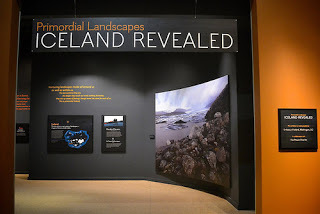
A large hall on the main floor of the museum, opening out from the famous elephant's rotunda, was set aside for the exhibition. The photographs were immense--one covered a whole wall--and numbered 41, I learned from the press materials. I was not inclined to count. I was mesmerized. Iceland all around me: Beauty all around me. Glaciers, icebergs, volcanoes, snow, steam vents, sulfur pots, cairns, a turf house, some trees. Using a large format digital Hasselblad, Pitcairn captured the color and detail of every lichen-coated stone, every leafless birch twig, every shimmer of ice or mineral rime or Northern Lights.
We were the only ones in the hall for the most part; a few tourists wandered through, but none lingered. We amused ourselves by guessing the names of places without reading the captions--some of which gave no place names, in any case.
We remarked at how odd it was that none of the scenes showed a single tourist. It's hard, nowadays, to find a time when some of these beauty spots are abandoned.
We played at picking our favorites: If you could afford one, which would you want on your own wall? I dithered between a stark scene, nearly black-and-white, of snow and peaks and wind-pruned trees and the glorious glacier shot that opened the show (and made the cover of the book).
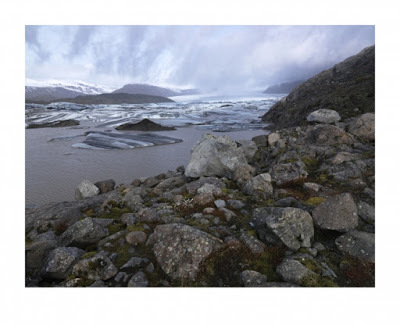 Photo by Feodor Pitcairn, courtesy the Smithsonian's press office.
Photo by Feodor Pitcairn, courtesy the Smithsonian's press office.My Icelandic colleagues passed those by. On the far wall, in a cluster of images, was a misty green fjord-side graced with two sheep. Those two sheep were the only animals Pitcairn had found in his imaginary Iceland. "That one," said Halla. "I would like that one for my birthday." (It is not among those images made available by the Smithsonian press office.)
In 1996, I spent a summer living in an abandoned farmhouse on the west coast of Iceland. The sea rose into the hayfields at high tide. Behind us stretched a vast jumbled field of rough lava. Across the fjord, snow-capped mountains fenced the sky, the grand shield-volcano of Snaefellsjokull rising Fuji-like at their furthest tip. I took well more than 41 photographs of primordial Iceland from that spot, each of them touching my mind, in Ari's phrase, and encouraging my imagination.
The next year I met a family who had once farmed there and had chosen to move away. "It's very beautiful," said the farmwife, "but the tides kept taking the sheep."
I will never see the Iceland she saw--or that my Icelandic colleagues see--or that Pitcairn photographs. As MacFarlane explains in Mountains of the Mind, most of what we see in a landscape we bring to it.
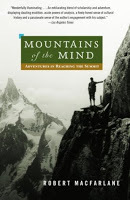 Feodor Pitcairn's exhibition "Primordial Landscapes: Iceland Revealed" runs through April 2017. Photos of and from the exhibit are courtesy of the Smithsonian's press office.
Feodor Pitcairn's exhibition "Primordial Landscapes: Iceland Revealed" runs through April 2017. Photos of and from the exhibit are courtesy of the Smithsonian's press office.Mountains of the Mind: Adventures in Reaching the Summit, by Robert MacFarlane, was published in 2003 by Random House. I wish I could write like him.
If you'd like to come to Iceland with me and see the land of my imagination, sign up for my "Sagas and Vikings" tour, July 10-16, 2016, at America2Iceland.com.
Published on January 20, 2016 07:00
January 6, 2016
The Viking Home of the Lewis Chessmen
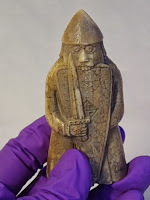 The Lewis chessmen, the subject of my book, Ivory Vikings, were found on the Isle of Lewis in westernmost Scotland in the early 1800s. The story of their finding is a bit muddled--maybe on purpose--and there are at least two plausible find spots.
The Lewis chessmen, the subject of my book, Ivory Vikings, were found on the Isle of Lewis in westernmost Scotland in the early 1800s. The story of their finding is a bit muddled--maybe on purpose--and there are at least two plausible find spots.Researching the question, I stayed at a guesthouse near the most likely spot, at Baile-na-Cille in Uig. "Baile-na-Cille" is Gaelic for "place of the church." "Uig" comes from the Norse word "vík," the root of "Viking," and the area does indeed have a Viking history.
One rainy day in June, Kevin Murphy, the assistant archaeologist at Museum Nan Eilean in Stornoway, met me there to give me a tour of the nearby Viking Age sites--or at least those that archaeologists have happened upon. Finding ancient sites is difficult here: the landscape can change dramatically in a very short time.
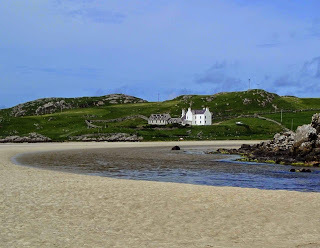 Baile-na-cille, Isle of Lewis"From late autumn right through to March," Kevin explained, "you can have huge winds here. The whole area can look different after a few months. The whole west side of the Hebrides is like this. You could have three to four meters of sand covering a village and nobody would know about it." Mixed with the sand is pumice from volcanic eruptions in Iceland, the nearest land due west.
Baile-na-cille, Isle of Lewis"From late autumn right through to March," Kevin explained, "you can have huge winds here. The whole area can look different after a few months. The whole west side of the Hebrides is like this. You could have three to four meters of sand covering a village and nobody would know about it." Mixed with the sand is pumice from volcanic eruptions in Iceland, the nearest land due west.We drove a mile or so north to an arc of golden beach called “Borg Beach,” from the Norse for fort. Here, for example, Kevin said, "You’ve got a massive build-up of sand." He gestured toward one of the headlands. "That whole area of green behind the haze is all habitation of some description. It’s a bit conjectural. Nobody’s looked into it. Over there," he said, turning, "that telephone pole is stuck in an Iron Age wheelhouse."
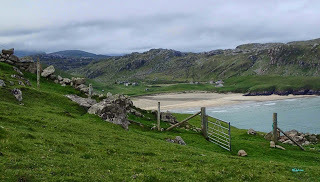 Borg, Isle of LewisIn the garden of the school behind us, in 1915, the skeleton of a woman was discovered. She had been buried in a typical Viking Age apron gown, with two large oval brooches fastening the straps. "This skeleton was eroding out of the hill, about here, give or take," Kevin said. "The interesting part is that the skeleton gives the impression that it’s early Norse."
Borg, Isle of LewisIn the garden of the school behind us, in 1915, the skeleton of a woman was discovered. She had been buried in a typical Viking Age apron gown, with two large oval brooches fastening the straps. "This skeleton was eroding out of the hill, about here, give or take," Kevin said. "The interesting part is that the skeleton gives the impression that it’s early Norse."Mary Macleod Rivett, another archaeologist working in the Hebrides, Kevin said, "met an old woman who had been at that school then. When Mary was talking to this old lady, she said, 'Oh, there was another one as well, with a helmet and a spear.' What happened to it? 'They put it in someone's shed and it fell to pieces.'"
We drove on to Reef, the site of another ancient graveyard. "What you’re seeing as a dump is an Iron Age burial. It's been completely excavated. Viking Age graves were found here too. This was just a green hillside. The sheep rubbed, the grass eroded, there was this 'blow out'"--a wind storm that scoured sand away until people started seeing skeletons poking out of the dune. "The wind can be really powerful in the winter," Kevin said. "If it's in the right direction, it just starts taking things out. In aerial photos from the 1940s, this is just a grassy hill."
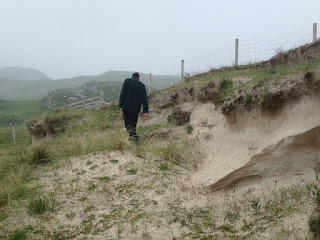 Reef, Isle of LewisFrom the headland on which the graves were found, the golden sand beach stretches out for miles. A river bisects it, flowing from a shallow lake thick with grass and reeds. "The loch looks like a grassy field," said Kevin, "but if you stepped into it you’d be swimming." Between the loch and the beach are ranks of sand dunes riddled with rabbit warrens. As they dig their maze-like runs, the rabbits often turn up ancient artifacts. "Some years you don't get anything," Kevin said. "Some years the rabbits are very busy and you get boat rivets. They could easily be Viking. I think these lochs were probably used as a safe place to pull your boats in for the winter."
Reef, Isle of LewisFrom the headland on which the graves were found, the golden sand beach stretches out for miles. A river bisects it, flowing from a shallow lake thick with grass and reeds. "The loch looks like a grassy field," said Kevin, "but if you stepped into it you’d be swimming." Between the loch and the beach are ranks of sand dunes riddled with rabbit warrens. As they dig their maze-like runs, the rabbits often turn up ancient artifacts. "Some years you don't get anything," Kevin said. "Some years the rabbits are very busy and you get boat rivets. They could easily be Viking. I think these lochs were probably used as a safe place to pull your boats in for the winter."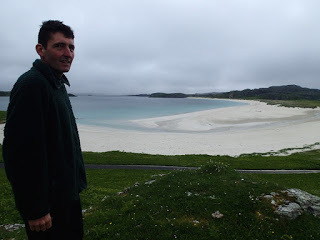 Archaeologist Kevin MurphyAt the end of the beach is a pre-Viking drystone tower or broch. "It’s only ankle high now, but you're standing on the top. There’s 20 to 30 feet of sediment covering it." To the Vikings it would have been a distinctive landmark. "Along the back of that hill, there’s been Viking Age artifacts found. You can see walls and mounds and all kinds of interesting things. Check Google Earth--you can see them that way. There's all those humps and bumps! This place really stands out for Norse. This is the spot."
Archaeologist Kevin MurphyAt the end of the beach is a pre-Viking drystone tower or broch. "It’s only ankle high now, but you're standing on the top. There’s 20 to 30 feet of sediment covering it." To the Vikings it would have been a distinctive landmark. "Along the back of that hill, there’s been Viking Age artifacts found. You can see walls and mounds and all kinds of interesting things. Check Google Earth--you can see them that way. There's all those humps and bumps! This place really stands out for Norse. This is the spot."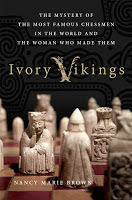 Read more about Ivory Vikings on my website, http://nancymariebrown.com, or check out these reviews:
Read more about Ivory Vikings on my website, http://nancymariebrown.com, or check out these reviews:"Briefly Noted," The New Yorker (November 2): http://www.newyorker.com/magazine/2015/11/02/briefly-noted-the-blue-guitar (scroll down)
"Bones of Contention," The Economist (August 29): http://www.economist.com/news/books-and-arts/21662487-bones-contention
"Review: Ivory Vikings," Minneapolis Star Tribune (August 29): http://www.startribune.com/review-ivory-vikings-by-nancy-marie-brown-the-mystery-of-the-lewis-chessmen/323230441/
Published on January 06, 2016 07:32



